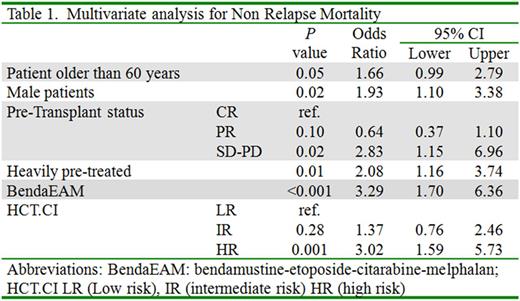Abstract
Background. Hematopoietic Stem Cell Transplant Comorbidity Index (HCT.CI) score, described by Sorror, is a useful tool to assess the risk for Non Relapse Mortality (NRM) after Allogeneic HSCT. The impact of this score in Autologous HSCT is still to be confirmed.
Aims. To determine the impact of HCT.Ci score in the morbidity and mortality after autologous HSCT, assessing the 100 day morbidity defined as orothraqueal intubation (OTI), dialysis or shock (defined as vasopressors need), 100 day mortality, early morbi-mortality (combined end-point by any of the previous end-point) and long term NRM.
Materials and Methods. We retrospectively reviewed 1478 medical records of adult patients who received an autologous HSCT in our centre between October 2002 and April 2016. Median age was 49 years (range 16-74 years), 58% were male, prevalent diseases were Multiple Myeloma (48%), Non Hodgkin Lymphoma (27%) and Hodgkin Lymphoma (18%), 49% were in complete remission, 46% received one chemotherapy scheme before transplant, 41% two schemes and 12% three or more (heavily pre-treated). In respect to conditionings, melphalan was used in 48% of the cases, CBV in 25%, BEAM in 8% as well as BendaEAM. Seventy five percent received an infusion of stem cells CD34+≥3x10.6/kg. Regarding comorbidities, 58% had low risk (LR) HCT.CI (score 0), 32% intermediate risk (IR) (1-2) and 11% high risk (HR) (≥3). For univariate analysis we use Chi2 for dichotomic variables, Kaplan-Meier for Overall Survival (OS) and cumulative incidence for NRM; for multivariate analysis we used logistic regression for dichotomic and Cox regression for time dependant variables.
Results. Median follow up was 1.9 years. Early mortality (day 100) was 2.8%, 5.6% required OTI, 4.8% required vassopresors and 2.2% dialysis, 1-3 years NRM and OS were 4.3-5.2% and 89-77% respectively. High risk HCT.Ci patients had a significant increase in 100 day mortality compared to IR and LR (7% vs.3% vs. 2% respectively, p=0.002), OTI (12% vs. 7% vs. 4%, p<0.001), dialysis (4.5% vs.2.6% vs. 1.5%, p=0.04), shock (10% vs.6.4% vs. 3%, p<0.001), early morbi-mortality (15% vs.9 % vs. 4.6%, p<0.001) and NRM (1-3 years 9.2-13% vs. 3.8-3.8% vs. 3.5-4.5%, p<0.001) (figure 1). After multivariate analysis these outcomes remain significant (showed as OR with 95% CI, IR and HR compared to LR): early mortality (1.8, 0.8-4.2 and 3.9, 1.6-9.7, p=0.003), OTI (2.1, 1.2-3.7, p<0.01 and 3.9, 2.0-7.5, p<0.001), dialysis (2.2, 0.8-5.5 and 4.1, 1.4-11.7, p<0.01), shock (2.7, 1.4-4.9, p=0.001 and 4.4, 2.1-8.9, p<0.001), early morbi-mortality (2.4, 1.4-4.0, p=0.001 and 4.2, 2.3-7.6, p<0.001) and NRM (1.3, 0.7-2.4 and 3.0, 1.5-5.7, p=0.001) (table 1). No significant impact was observed in OS. Other than comorbidities, significant impact was observed in early mortality (pre-transplant status, heavily pre-treated patients and BendaEAM conditioning), OTI (NHL, heavily pre-treated patients, BendaEAM conditioning), dialysis (pre-transplant status and BendaEAM conditioning), shock (NHL, heavily pre-treated patients and BendaEAM conditioning), morbi-mortality (NHL and BendaEAM conditioning) and NRM (male patients, NHL, pre-transplant status, heavily pre-treated patients and BendaEAM conditioning).
Conclusions. We observed that HCT.CI had a significant impact on Autologous HSCT treatment related mortality basically due to early toxicity express as 100 day mortality and the three main morbidity outcomes as well as the combined end point. This observation should be confirmed in larger series.
No relevant conflicts of interest to declare.
Author notes
Asterisk with author names denotes non-ASH members.



This feature is available to Subscribers Only
Sign In or Create an Account Close Modal